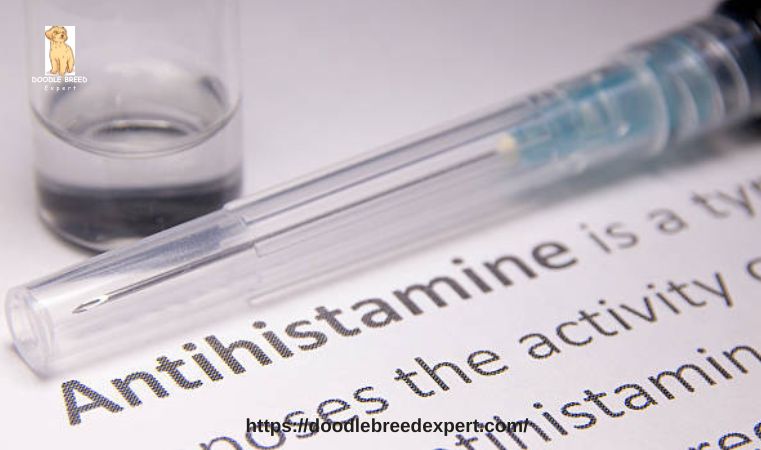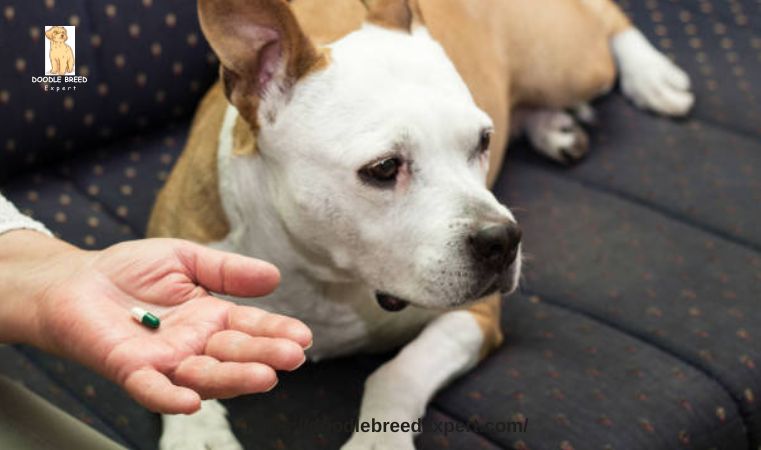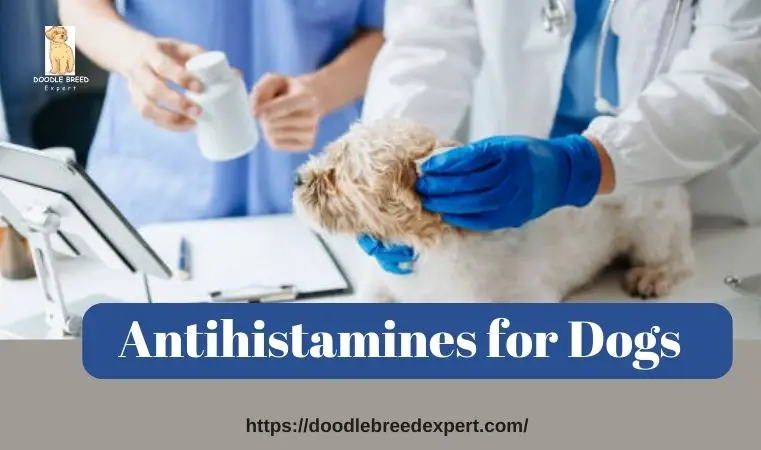For many dogs, allergies are a common issue. When a typically safe situation causes the dog’s immune system to overreact, an allergic reaction happens. When the body overreacts, histamine is released into the body, causing symptoms of allergies such as sneezing, runny nose, eyes and skin scratches.

Dog allergy symptoms may be reduced with antihistamines that reduce the effects of histamine. This extensive guide will cover the following topics
- mechanism of action of antihistamines
- various antihistamines used for dogs, their safety and efficacy
- dosage and administration
- potential side effects
- some general advice on using antihistamines for dog allergies.
Allergies in Dogs
Allergies can develop at any age in dogs, though they often start when dogs are young. Some typical dog allergen sources that can trigger allergic reactions include dog skin allergy solutions tablets. Let’s understand in detail.
- Small parasitic insects called fleas reside on dogs’ skin and feed on their blood. Some dogs become extremely sensitive to flea saliva. An intense itching allergic reaction occurs when a flea bites a dog like this. Dog allergies most commonly appear as flea allergy dermatitis. Dogs with this allergy may frequently scratch and bite at their skin, resulting in severe itching, redness, hair loss, scabs and skin infections.
- A dog allergy may be to one or more of the following: wheat, dairy eggs, corn, soy, lamb, beef, or eggs. Dogs that suffer from food allergies frequently get ear infections, diarrhoea, vomiting, and itchy skin.
- Allergies in dogs can be brought on by inhaling pesticides, dust mites, mould spores, pollen, cigarette smoke cleaning products, perfumes and other airborne particles. Itchy skin, runny nose, eyes, coughing, sneezing and other symptoms are caused by these inhalant allergies.
- Specific shampoos, bedding materials, and woollike clothing might cause contact allergies in dogs. Common symptoms for the dog include localized itching, hives and skin irritation.
Antihistamines give Relief from Allergy Symptoms.
Antihistamine is the primary particle involved in an allergic reaction. It works by decreasing its activity. What they do to aid in relief is as follows.
- The immune system releases histamine whenever a dog comes into contact with an allergen. This histamine causes symptoms including itching, swelling, and mucus secretion by binding to specific H1 receptors on cells.
- Antihistamines limit the effects of histamine by preventing it from binding to cell receptors. This helps to relieve the symptoms.
- In addition to stabilizing these inflammatory chemical-storing and releasing cells, certain antihistamines also aid in the function of basophils and mast cells. This helps to manage allergic symptoms over the long run.
- Dogs with allergic skin diseases can break the itching and scratching cycle by using antihistamines that reduce inflammation. Skin healing can now begin as a result.
- Antihistamines decrease mucus secretion, clearing runny nose, itchy eyes, coughs and other upper respiratory allergy symptoms.
- More potent antihistamines can help reduce hives, swelling and other acute allergic reactions.
So, in summary, antihistamines control the root causes of allergy symptoms, histamine release, and activity. By targeting this mechanism, they can provide rapid and sustained relief from allergy misery in dogs.

Types of Antihistamines Used for Dog
There are two main classes of antihistamines used for dog allergies.
H1 Antihistamines
Mainly found on cells in the skin, gastrointestinal system, lungs nose, mouth, eyes and so on, H1 histamine receptors are the target of these antihistamines. Besides easing related allergy symptoms, including itching, hives watery eyes, runny nose etc, h1 anti histamines also prevent the effects of histamine on these sites. Dogs are frequently prescribed OTC oral h1 antihistamines like
- hydroxyzine (Atarax)
- clemastine (Tavist)
- diphenhydramine
- chlorpheniramine
- Topical formulations such as hydrocortisone cream can be applied to ease local irritation.
H2 Antihistamines
These antihistamines work by targeting H2 histamine receptors found on stomach lining cells. H2 antihistamines can prevent allergy-related gastric ulcers, vomiting and acid reflux in dogs by limiting the effects of histamine on gastric cells.
Famotidine, cimetidine and ranitidine are three standard h2 antihistamines used in dogs. They are frequently taken in addition to h1 antihistamines to provide complete allergy relief.
Dogs with severe seasonal or perennial allergies that are not adequately controlled with oral over-the-counter antihistamines alone may be given stronger antihistamine shots, oral steroids immunotherapy by a veterinarian.
Are Antihistamines Effective for Dog Allergies?
For mild to moderate allergy symptoms, antihistamines can relieve many dogs. Here are some critical points on their effectiveness
- Antihistamines relieve acute symptoms like itching, swelling, hives, and runny eyes and nose. Effects are typically seen within 30 to 60 minutes of giving the medication.
- Chronic allergy symptoms like recurring ear and skin infections, hair loss, and hot spots also improve significantly with regular antihistamine use over weeks to months.
- Sedating first-generation OTC antihistamines like diphenhydramine are moderately effective for most allergy dogs. Non-sedating newer-generation antihistamines may be better options.
- Short-nosed breeds like Pugs and Buldogs may not respond as well to oral antihistamines as other dog breeds.
- Antihistamines work best when combined with other treatments like medicated shampoos omega-3 fatty acids, avoiding allergen triggers, managing secondary infections etc., to provide comprehensive allergy relief.
So, while antihistamines may not completely cure allergies in all dogs, they provide significant symptomatic relief, especially when used properly under veterinary guidance and other therapies. This makes them useful for managing and improving the quality of life for dogs with allergies.
Read Also: How To Comfort a Dog with Pancreatitis
Antihistamines Safe for Dog
As long as dogs get antihistamines in the right amounts as advised by their veterinarian, they are usually relatively safe. It’s essential to be aware of the negative impacts and precautions, though:
- In dogs, tiredness sedation, and lethargy are common side effects of many first-generation H1 antihistamines such as diphenhydramine (Benadryl). As the dog’s body adapts this impact might gradually fade. There are now antihistamines with shorter half-lives that don’t sedate.
- Anti-histamines can temporarily cause dogs to have dry mouths and become more thirsty by reducing salivary secretion in the mouth. Make sure there is always access to fresh water.
- Due to urinary retention, several anti histamines make it difficult for the dog to urinate. If your dog is having difficulty urinating or appears to be unable to do so, seek immediate veterinary attention.
- Some dogs may become hyperactive or excitable with antihistamines instead of sedated. Consult your vet if this occurs.
- Antihistamines should not be given with other drugs like anticholinergics tranquillizers opioids etc. that also cause sedation without vet guidance.
To avoid complications, follow your veterinarian’s dosage instructions carefully for antihistamines. Seek prompt medical attention if any concerning side effects develop in your dog after starting antihistamine therapy.
What to Monitor with Long-Term Antihistamine Use in Dogs?
Here are some things to watch out for when antihistamines are taken long-term consistently to treat dog’s chronic allergies
Effectiveness
Monitor the allergy symptoms in your dog and record any improvement with continued antihistamine treatment. If symptoms do not decrease, make an appointment with the veterinarian.
Weight Gain and Appetite Change
Certain antihistamines may impact hunger. Check for weight reduction or decreased food consumption by often weighing your dog.
Increased thirst and urination
These symptoms may indicate renal issues. Keep an eye on how much water and pee your dog is drinking.
Skin infections
Treat your dog immediately if you see any cuts, hot spots, or infections growing on their skin. Subsequent skin infections brought on by allergies might not be prevented by antihistamines alone.
Bloodwork
Regularly taking antihistamines may require your veterinarian to order blood tests to check your kidney and liver health.
Behaviour
While your dog is on antihistamines long term, report any behavioural changes, such as increased hyperactivity lethargy, restlessness or other changes, to your veterinarian.
Combination therapy
If more allergy control is required, work with your veterinarian to try additional therapies such cytopoint injections, medicated shampoos, omega fatty acids or allergen-specific immunotherapy. Particularly if your dog is on antihistamines for an extended period be aware of any troubling signs and be in close contact with your veterinarian. This allows quick treatment changes as necessary.
General Tips for Antihistamine Use in Dogs with Allergies
Extra information on the safe and efficient use of antihistamines to treat dog allergies is provided below.
- Select the appropriate antihistamine following your dogs symptoms and the advice of your veterinarian. Phamotidine (Pepcid) relieves vomiting, while H1 antihistamines such as diphenhydramine are effective for itching.
- Use liquid forms or tablets with the appropriate strength to administer the proper dosage based on your dog’s weight. It is harmful to overdose and ineffectual to underdose.
- If your pet isn’t feeling better after taking one antihistamine, your veterinarian may suggest switching to another or using a combination.
- When starting antihistamine therapy, watch for any side effects in your dog, such as increased thirst changes in urine, vomiting, diarrhoea lethargy, or extreme hyperactivity.
Conclusion
By reducing histamine release in the body, antihistamines can offer dogs much-needed relief from the pain of allergies. Antihistamines are usually safe when taken as directed by a veterinarian and may significantly improve allergy symptoms and quality of life. Long-term allergy control in your dog can be achieved by regularly monitoring him and working with your veterinarian to provide the best antihistamine therapy and other therapies.






